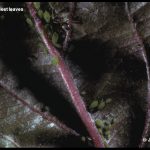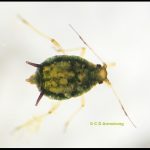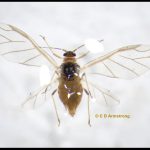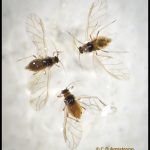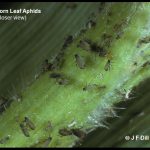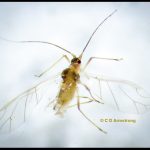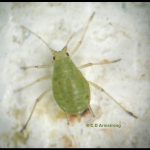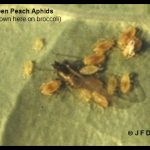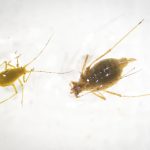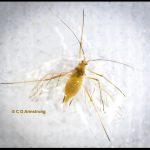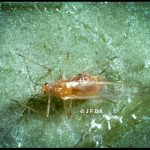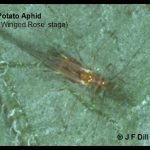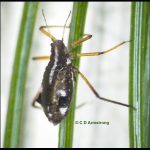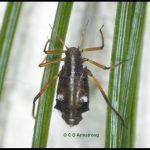Aphids
Often called plant lice, aphids are small, soft-bodied insects. They range in color from black to green to yellow. Their numbers may greatly increase in a short time and crowding stimulates the production of winged forms. They may cover the entire surface of a leaf or stem. They can be vectors of viruses. Encourage natural predators, such as ladybird beetles or lacewing larvae, to help keep their populations in check. Lacewing eggs can be purchased from seed companies. These eggs soon hatch and yield good aphid control. There are also chemicals that can be used to control them.
- Aphids on beet leaves
- Aphids on pepper leaves
- Bird Cherry Oat Aphid / Oat-Birdcherry Aphid (Rhopalosiphum padi) (central Maine; 7/10/2023)
- Buckthorn Aphid (winged form) (Aphis nasturtii) (close relative of the Melon/Cotton Aphid) (central Maine; 6/28/2023)
- Buckthorn Aphids (winged form) (Aphis nasturtii) (central Maine; 6/28/2023)
- Corn Leaf Aphids
- Corn Leaf Aphids (closer view)
- Foxglove Aphid (winged form (Aulacorthum solani) (central Maine; 6/28/2023)
- Foxglove Aphid on a lettuce leaf (this aphid has a wide host range)
- Green Peach Aphid (Myzus persicae) (Columbia Falls, ME; 6/25/2009)
- Green Peach Aphid (winged form) (Myzus persicae) (the rectangular, dark-colored patch or ‘mask’ on the abdomen is unique to the species but is found only on the winged individuals)
- Green Peach Aphids on broccoli
- Potato Aphids (Macrosiphum euphorbiae) (central Maine; 6/29/2023) (legs and antennae are long relative to most other species of aphids; the antennae are roughly the same length as the body)
- Potato Aphid (winged form) (Macrosiphum euphorbiae) (Exeter, Maine; 6/27/2023)
- Potato Aphid (Macrosiphum euphorbiae) (winged form)
- Potato Aphid (‘Winged Rose’ stage)
- White Pine Aphid (Unity, ME; 9/25/2024)
- White Pine Aphid (Cinara strobi) (on white pine needles in Unity, ME; 9/25/2024)
Additional Information:
- Aphids in Home Yards and Gardens (University of Minnesota Extension)
- Aphids (Cornell)
- Managing Aphids in Greenhouses (Cooperative Extension; Univ. of Wisconsin-Madison)
- Aphid and Adelgid Pests of Conifers [pdf] (Oregon State University)
- Sucking Insects that Affect Vegetable Plants (UMaine Extension)
- Some Individual Species of Aphids:
- Bird Cherry Oat Aphid / Oat-Birdcherry Aphid (BugGuide.net)
- Black Bean Aphids (BugGuide.net)
- Corn Leaf Aphids (BugGuide.net)
- Green Peach Aphids
- Foxglove Aphids (UC IPM)
- Potato Aphids (BugGuide.net) | Potato Aphids on Ornamental Plants (NC State Extension)
- Potato (and other) Aphids (part of UMaine Extension’s Potato IPM Program)
- White Pine Aphids (BugGuide.net)
- Woolly Beech Aphids (BugGuide.net)

